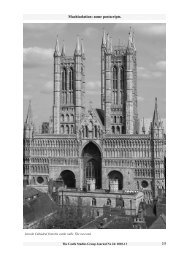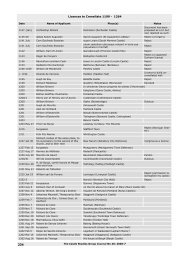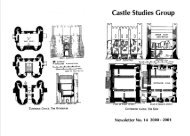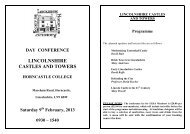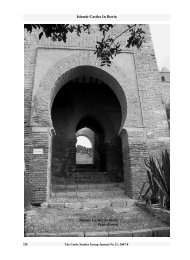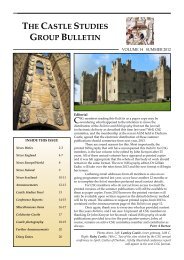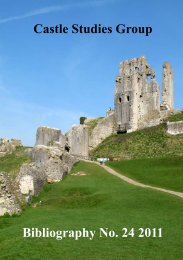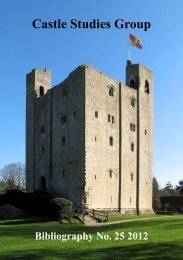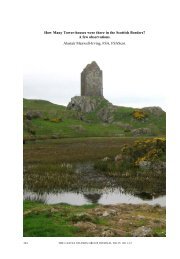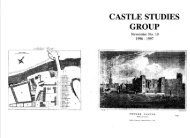Castle Studies Group Bibliography No. 22 2009
Castle Studies Group Bibliography No. 22 2009
Castle Studies Group Bibliography No. 22 2009
You also want an ePaper? Increase the reach of your titles
YUMPU automatically turns print PDFs into web optimized ePapers that Google loves.
communities, and it is suggested that this could be one of the reasons behind the establishmentof Henry III’s Montgomery castle, with its views east, into lands which Llywelyn couldinfluence.The final publication in this section is Bob Silvester’s study of a map of 1629 of Welshpool,one of the earliest maps of a town in Wales; it includes what must be the earliest view of Powis<strong>Castle</strong>.Individual sites - ScotlandRowallan <strong>Castle</strong> in Ayrshire is the subject of the first in a new series of publications fromHistoric Scotland – A palace fit for a laird. After an initial glance at this report and the secondin the series, on Cadzow (see below), one might wonder why such relatively slim volumes werenot published as articles in journals, but a more thorough perusal shows that a monographformat has been able to do full justice to the work of the authors and contributors. There is noindication of what other titles are proposed, but I wish HS every success with the series – itwould be interesting to see just how well they sell; Rowallan costs £14.95 and Cadzow £9.95,and can be acquired by contacting Natasha Troitino at HS on 0131 657 8469 ornatasha.troitino@scotland.gsi.gov.ukRowallan <strong>Castle</strong> was a country seat of the Muirs for over four centuries, the family beingmiddle-ranking Scots nobility, but from the eighteenth century the castle fell into neglect.MacGibbon and Ross’s great work of 1887-92, Castellated and domestic architecture ofScotland, described in some detail the fine woodwork in the castle, such as the panelling.Rowallan passed into State care in 1950, and so is now in the care of Historic Scotland. Workon the fabric revealed a Bronze Age burial, but the report by Gordon Ewart and DennisGallagher is of course mainly on the building. After the introduction, the first part covers thearchaeology and building survey (four chapters), with the second part devoted to the historicalresearch (five chapters). There is a long technical appendix by Ewart that analyses thecomponents of the castle.The ruinous north-east tower of Rowallan was excavated, but has been difficult to date. Itcould be as early as the late thirteenth century. Part of the south range is seen as being latefifteenth or early sixteenth century on the evidence of the dumb-bell gunloops, and then in thesixteenth century Mungo Mure, followed by John Mure, built the Renaissance house we seetoday, including the twin-towered entrance. There were later additions and alterations made bythe family, and the excellent colour plans on pages 54-57 (figs 48-51), together with theelevations (pages 58-59, figs 52-55), enable one to see at a glance how the building developed.The study of the late sixteenth-century Monimail (or Beaton’s) Tower in Fife undertakenfrom 1983 to 2000 examined its history and architecture, and there were also archaeologicalexcavations. The report has been edited by Stuart Farrell. The tower was part of the palace ofthe archbishops of St Andrews that Sir James Balfour acquired and developed in 1564. Thetower bears Balfour’s initials and a date (1578), although these may be insertions in earlierfabric.The castle in the woods is the second of Historic Scotland’s Archaeology Reports, coveringexcavations at Cadzow from 2000 to 2003. This highly ruinous and once tree-covered sixteenthcenturycastle in Lanarkshire was purchased by the State in 1978, together with part of thesurrounding designed landscape, and many castle students, certainly those outside Scotland,would have only become familiar with the site from reading Denys Pringle’s article on it in13



